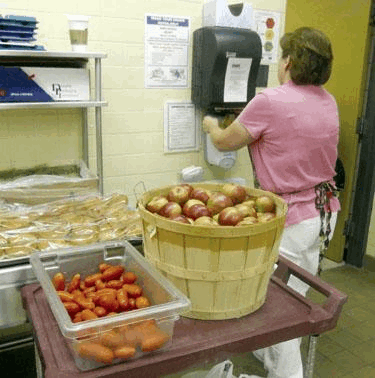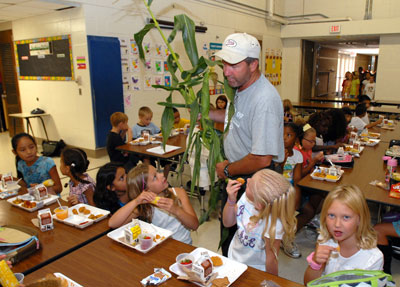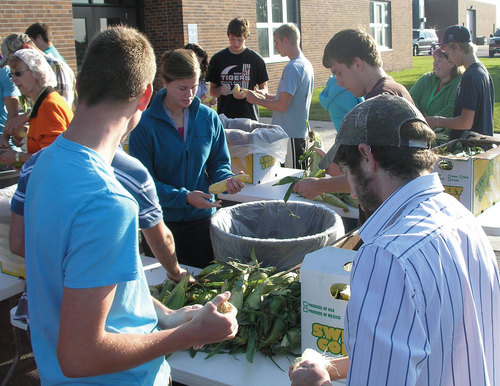"When schools become a model of what would be a healthy meal, then we are going to improve overall children's health." --Lynn Mader.
The other day I chatted with Lynn Mader, an IATP (Institute for Agriculture and Trade Policy) staff member who works on the Farm to School program in Minnesota. We talked about the successes and challenges of the program and how it is working to bring positive change to our community, to our state and to our country.
Farm to School was started about 10 years ago in California, Florida and the East Coast. It was developed as a way of bringing fresh, minimally processed foods and nutrition into schools, while supporting local farmers. Five years ago, the Farm to School program (F2S) came to Minnesota with 10 school districts participating, a number that has now grown to include 134 districts state wide. Almost half of Minnesota's total of 300.
 Sky Oaks Elementary School cook helper Brenda Becker with fresh produce from Akerberg Acres, a family-run farm in Belle Plaine. Photo by Michael Ricci-Sun NewspapersLast year the Minnesota School Nutrition Association, various associations of school food service professionals and other partners, dedicated a week to the Farm to School program. This year governor Mark Dayton declared all of September to be Farm to School month, a decision perhaps prompted by the program's rapid growth and success.
Sky Oaks Elementary School cook helper Brenda Becker with fresh produce from Akerberg Acres, a family-run farm in Belle Plaine. Photo by Michael Ricci-Sun NewspapersLast year the Minnesota School Nutrition Association, various associations of school food service professionals and other partners, dedicated a week to the Farm to School program. This year governor Mark Dayton declared all of September to be Farm to School month, a decision perhaps prompted by the program's rapid growth and success.
Schools are working to engage F2S not just for a week or a month, but for the entire school year. That work must take place in three areas for the program to be most successful. Mader specifically states that, "We talk of Farm to School having three components: cafeteria, community and classroom."
Traditionally, school cafeterias have gotten a lot of negative press for serving highly processed foods with high-fat and high-sugar contents. By bringing interesting and new local ingredients into their cafeterias, the Farm to School program is giving food service workers the ability to be more creative and innovative with what they serve. This can only help to make the food better overall. This past September, many cafeterias throughout the state were serving locally grown fresh produce and will continue to serve local food as much as possible in the coming year. This can be challenging in Minnesota—September is the only full month in the Minnesota school year with access to a wide array of local fresh fruits and vegetables—but there are nearly year-round products available like squash, apples, potatoes, wild rice, beef, bison, beans, wheat and corn.
 Gary Pahl of Pahl’s Market visited Southview Elementary on September 12 to promote the locally grown fruits and vegetables being served for lunch. Photo by Rick Orndorf of thisweeklive.com.Farm to School also seeks to build community among schools, students and farmers as part of the project's big picture. If schools could work with farmers to create a new market for their products, it could help benefit our agricultural economy. "This school-and-farmer relationship was the way our food system used to work, but that economic partnership got dismantled," says Mader. "As a result, farmers are sometimes a little hesitant to become involved with the project, skeptical that schools will not really be a viable and sustainable market for them. Schools sometimes worry at first that they will not be able to get the products they want and need from local farmers. So F2S is trying to rebuild this link—and trust—between school food systems and farmers. These relationships are growing and it's inspiring to see. Farmers are enthusiastic and caring about children's health in their community. According to a survey taken at the end of last school year, all of the farmers who participated in the F2S will continue to do so."
Gary Pahl of Pahl’s Market visited Southview Elementary on September 12 to promote the locally grown fruits and vegetables being served for lunch. Photo by Rick Orndorf of thisweeklive.com.Farm to School also seeks to build community among schools, students and farmers as part of the project's big picture. If schools could work with farmers to create a new market for their products, it could help benefit our agricultural economy. "This school-and-farmer relationship was the way our food system used to work, but that economic partnership got dismantled," says Mader. "As a result, farmers are sometimes a little hesitant to become involved with the project, skeptical that schools will not really be a viable and sustainable market for them. Schools sometimes worry at first that they will not be able to get the products they want and need from local farmers. So F2S is trying to rebuild this link—and trust—between school food systems and farmers. These relationships are growing and it's inspiring to see. Farmers are enthusiastic and caring about children's health in their community. According to a survey taken at the end of last school year, all of the farmers who participated in the F2S will continue to do so."
 Morris Area ag students on Tuesday husked sweet corn that will be included on the school's cafeteria menu. More and more, local foods are being incorporated into food service offerings. Photo thanks to agweek.com.The third component is education—in the cafeteria, in school gardens or on farms, as well as in the classrooom. Although currently food served in the cafeteria is not connected to the curriculum in most schools, many are starting gardens and students are becoming more interested in seeing how their food is grown, and then helping to grow it. In the end, if they feel like they are a part of producing the food, they are more likely to eat it in the cafeteria.
Morris Area ag students on Tuesday husked sweet corn that will be included on the school's cafeteria menu. More and more, local foods are being incorporated into food service offerings. Photo thanks to agweek.com.The third component is education—in the cafeteria, in school gardens or on farms, as well as in the classrooom. Although currently food served in the cafeteria is not connected to the curriculum in most schools, many are starting gardens and students are becoming more interested in seeing how their food is grown, and then helping to grow it. In the end, if they feel like they are a part of producing the food, they are more likely to eat it in the cafeteria.
Farm to School is "creating its own momentum and enthusiasm," says Mader, and the program continues to grow. She sees a ripple effect of excitement across school boards, among food service workers, and with kids, farmers, teachers and parents. With regards to F2S as an answer to the health and obesity problems in this country, Mader says, "When schools become a model of what would be a healthy meal, then we are going to improve overall children's health," and in turn the health of the country. Mader's own enthusiasm inspired a "ripple effect" of excitement about F2S in me, too.
The photos were part of the ongoing coverage of Farm to School programs in Minnesota. Read more by following these links:
Local apples and trees at Dover-Eyota high school.
Cover photo of 7th graders cleaning corn at Hill-Murray school in Maplewood. Cover photo credit: Dianne Towalski.
Burnsville, Eagan and Savage schools involved in procuring local fruits and vegetables.
 Lizzie Holzapfel is a Yogi, food lover and writer. She lives in South Minneapolis and can be reached at: lizgirl06@yahoo.com. Her last article for SGT was: Letting Food Speak For Itself.
Lizzie Holzapfel is a Yogi, food lover and writer. She lives in South Minneapolis and can be reached at: lizgirl06@yahoo.com. Her last article for SGT was: Letting Food Speak For Itself.




